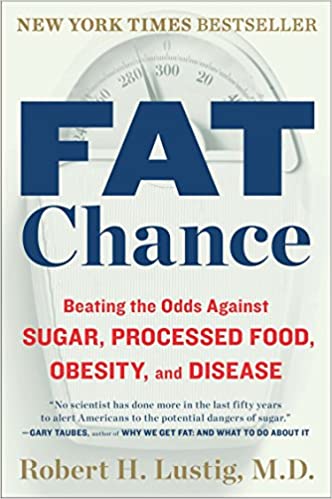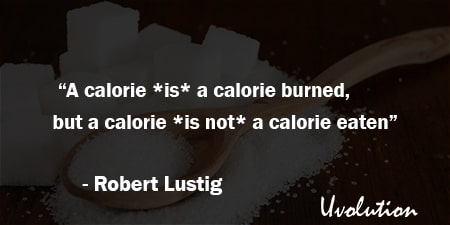Fat Chance by Robert Lustig Book Summary
The Book in 1 Sentences
Fat Chance: The Hidden Truth About Sugar, Obesity and Disease
“All the major U.S. governmental health agencies, the Centers for Disease Control (CDC), the U.S. Department of Agriculture (USDA), the Institute of Medicine (IOM), the National Institutes of Health (NIH), and the U.S. Surgeon General, say that obesity results from an energy imbalance:
eating too many calories and not getting enough physical activity. And they are right—to a point. Are we eating more? Of course. Are we exercising less? No doubt.
Despite knowing this, it hasn’t made any difference in the rates of obesity or associated diseases. More to the point, how did this epidemic happen and in such a short interval of just thirty years?
People say, ‘The food is there,’ and it is. But it was there before. People say, ‘The TV is there,’ and it is. But it was there before, and we didn’t have this caloric catastrophe. There’s more to this story, way more, and it’s not pretty.
Everyone blames everyone else for what has happened. No way is it their fault. Big food says it’s a lack of activity due to computers and video games. The TV industry says it’s our junk food diet.
The Atkins people say it’s too many carbohydrates; the Ornish people say it’s too much fat. The juice people say it’s the soda; the soda people say it’s the juice. The schools say it’s the parents; the parents say it’s the schools.
And since nothing is for sure, nothing is done. How do we reconcile all these opinions into a cohesive whole that actually makes sense and creates changes for the better for each individual and for all society? That’s what this book is about.” ~ Robert H. Lustig
7 BIG Ideas
Fat Chance Book Summary
1. A calorie is NOT a calorie
“Second, if a calorie is a calorie, then all fats would be the same because they’d each release 9.0 calories per gram of energy when burned. But they’re not the same. There are good fats (which have valuable properties, such as being anti-inflammatory) and bad fats (which can cause heart disease and fatty liver disease).
Likewise, all proteins and amino acids should be the same, since they release 4.1 calories per gram of energy when burned. Except that we have high-quality protein (such as egg protein), which may reduce appetite, and we have low-quality protein (hamburger meat), which is full of branched-chain amino acids, which has been associated with insulin resistance and metabolic syndrome.
Finally, all carbohydrates should be the same, since they also release 4.1 calories per gram of energy when burned. But they’re not. A closer look at the specific breakdown of the carbohydrate data reveals something interesting.
There are two classes of carbohydrate: starch and sugar. Starch is made up of glucose only, which is not very sweet and which every cell in the body can use for energy.
Although there are several other ‘sugars’ (glucose, galactose, maltose, and lactose), when I talk about sugar here (and in the rest of this book), I am talking about the ‘sweet’ stuff, sucrose and high fructose corn syrup, which both contain the molecule fructose.
Fructose is very sweet and is inevitably metabolized to fat. It is the primary (although not sole) villain, the Darth Vader of the Empire, beckoning you to the dark side of this sordid tale.”
“There’s one lesson to conclude from these three contradictions to current dogma: A calorie is not a calorie. Rather, perhaps the dogma should be restated thus: a calorie *is* a calorie burned, but a calorie *is not* a calorie eaten. And therein lies the key to understanding the obesity pandemic.”
“If you had any residual doubt about ‘a calorie is not a calorie,’ this analysis should remove it. Every additional 150 calories per person per day barely raised diabetes prevalence. But if
those 150 calories were instead from a can of soda, increase in diabetes rose sevenfold. Sugar is more dangerous than its calories. Sugar is a toxin. Plain and simple.”
Obesity is pandemic
“If obesity were just an American phenomenon it would be an epidemic, an outbreak of illness specific to a certain area. One might then blame our American culture for promoting it. Due
to our slippage in education and technological superiority, we’re labeled as ‘fat and lazy’ or ‘gluttons and sloths.’ Yet obesity is now a pandemic, a worldwide problem.”
2. Behaviors driven by hormones
Insulin
“Insulin, in common parlance, is known as the diabetes hormone. Diabetics inject insulin to
lower their blood glucose. But where does the glucose go? To the fat.
Insulin’s actual job is to be your energy storage hormone. When you eat something (usually containing some form of carbohydrate), your blood glucose rises, signaling the pancreas to release insulin commensurate with the rise in blood glucose. ...
Insulin then tops off the liver’s energy reserve by making liver starch (called glycogen), and shunts any amino acids from the blood into muscle cells.
Excess fatty acids, or blood lipids, are cleared into fat cells for storage for a ‘rainy day,’ where they get turned into greasy triglycerides (such as the fat surrounding your steak). There is no energy storage without insulin—it is the key that unlocks the door to the fat cell to let energy enter and subsequently be stored as fat.
Insulin makes fat—the more insulin, the more fat. And there it sits . . . and sits . . . for as long as there is insulin around. When the insulin levels drop, the process goes in reverse: the triglycerides get broken down, causing the fat cells to shrink—when it happens, that’s weight loss!—and the fatty acids reenter the bloodstream and travel back to the liver, where they are burned by the liver or other organs. In this way, by cycling our insulin up and down, we burn what we need, and store the rest.”
“There is no fat accumulation without insulin. Insulin shunts sugar to fat. It makes your fat cells grow. The more insulin, the more fat, period.
While there are many causes of obesity, excess insulin in some form is the ‘final common pathway’ for the overwhelming majority of them. Block it, and the fat cells remain empty.”
Leptin
“Leptin is a protein made and released by fat cells. It circulates in the bloodstream, goes to the hypothalamus, and signals the hypothalamus that you’ve got enough energy stored up in your fat.
The discovery of leptin closed the loop, providing a servomechanism (like your home’s thermostat) in which the body’s fat cells told the hypothalamus whether the animal was in energy surplus (obesity) or dearth (starvation).”
“High insulin blocks the leptin signal, mimicking ‘brain starvation’ ... so that we feel hungry even when we have eaten.”
“Their [obese people’s] hypothalami can’t see their leptin, so their brains think they’re
starving and will therefore try to increase energy storage (gluttony) and conserve energy
usage (sloth).”
3. Not all pounds are created equal
“Whenever we step on the scale, we are measuring the sum of four different body compartments, only one of which is bad for us.
1. Bone. The more bone the longer you live. ...
2. Muscle. More muscle is better for your health. Muscle takes up glucose. More exercise
means more muscle, and more muscle means better insulin sensitivity. ... When you are
building bone and muscle, you are providing a method for burning energy rather than
storing it, which leads to improving your health regardless of your weight.
3. Subcutaneous (or ‘big butt’) fat. This makes up about 80 percent of our total body fat and is
what gave Marilyn Monroe her hourglass figure. Believe it or not, more subcutaneous fat is
better for your health. ...
4. Visceral fat. The only compartment that is consistently bad for us is our visceral (aka
abdominal, ectopic, or ‘big belly’ fat. This consists of fat in areas where it doesn’t belong,
including fat inside your abdomen and inside your organs (e.g., liver and muscle). It makes
up about 20 percent of our total body fat, or about 4-6 percent of our total body weight.
Visceral fat is the fulcrum on which your health teeters.”
“The simplest and cheapest surrogate for determining your health status is your waist
circumference, which correlates with morbidity and risk for death better than any other health parameter.
This is arguably the most important piece of information in your entire health profile because it tells you about your visceral fat. A high waist circumference translates into the ‘apple’ shape that tips physicians off to risk for diabetes, heart disease, stroke, and cancer.”
“In a nutshell, your body fat is your biggest long-term risk for infirmity. Nothing correlates with diabetes, heart disease, and cancer better than your fat.”
4. Low sugar + high fiber
“Can low-fat and low-carb diets both be right? Or both wrong? What do the Atkins diet (protein and fat), the Ornish diet (vegetables and whole grains), and the traditional Japanese diet (carbohydrates and protein) have in common? On the surface they seem to be diametrically opposite.
But they all have one thing in common: they restrict sugar. Every successful diet in
history restricts sugar. Sugar is, bar none, the most successful food additive known to man.
When the food industry adds it for ‘palatability,’ we buy more. And because it’s cheap, some
version of sugar appears in virtually every processed foodstuff now manufactured in the world. Sugar, and specifically, fructose, is the Lex Luthor of this story.”
“Let’s look at all these diets. Some rely on fat for energy, others rely on carbohydrates for energy, and some use both. Yet they all work to control weight and improve metabolic health, and have been shown to reduce heart disease. What do they all share? Two things. They are all low in sugar, and they are all high in fiber (and therefore high in micronutrients). We’ve arrived.
That’s the point—that’s what matters. You now hold the keys to the kingdom. Naturally
occurring fructose comes from sugarcane, fruits, some vegetables, and honey. The first three have way more fiber than fructose, and the last is protected by bees. Nature made sugar hard to get.
Man made it is easy to get. And that’s the nugget of truth that the food industry and the
U.S. government won’t admit; because if they did, they’d have to scale back. And they either
can’t or don’t want to. That’s why the rates of obesity and chronic metabolic disease have
skyrocketed wherever the industrial global diet has been introduced.”
“As you will see, all successful diets share three precepts: low sugar, high fiber (which means
high micronutrients), and fat and carbohydrate consumed together in the presence of an
offsetting amount of fiber. Anything after that is window dressing.”
Fructose
“Fructose. Finally, we come to the Voldemort of the dietary hitlist: the sweet molecule in sugar. If it’s sweet, and it’s caloric, it’s fructose. Period. This is the one foodstuff whose
consumption has increased worldwide, and with reckless abandon.
And it is the one that children eat with no holds barred. We have animal and human data. We also have the golden ticket: correlation *and* causation. Every age group, including infants, has increased its consumption of fructose in the last thirty years. As far as I am concerned, this is where the action is.”
“Fructose isn’t the only cause of obesity, but it is the primary cause of chronic metabolic disease, which kills. . . slowly.”
5. Stop drinking juice and soda!
“The health-conscious among you may opt for juice over soda. For those of you who can afford
it, you skip the Sunny Delight in favor of ‘natural 100 percent fruit juices’ made by Odwalla or
other organic companies.
They tout multiple health benefits and claim that, because they are devoid of sweeteners, they are in fact good for you. Wrong. The fruit is good for you, because it also contains fiber. In fact, calorie for calorie, 100 percent orange juice is worse for you than soda, because the orange juice contains 1.8 grams of fructose per ounce, while the soda contains 1.7 grams of fructose per ounce.”
“The problem is that the shearing action of the blender blades completely destroys the insoluble fiber of the fruit. ... The sugar in the fruit will be absorbed as fast as if the juice were strained with no fiber at all.”
6. Consistent exercise
“Irrespective of weight, consistent exercise (even just fifteen minutes a day) is the single best way for people to improve their health. That’s 273 hours paid in for 3 years of life gained, or a 64,000 percent return on investment. The best deal of medicine.”
“Studies demonstrate that all the levels of PPAR-gamma coactivator 1-alpha (PGC-1a; the protein in muscle cells that turns on all the good muscle metabolic effects and tells the mitochondria to divide) decline within a day of cessation of exercise, and insulin sensitivity returns to baseline within fifteen days.
So, those of you weekend warriors who think you’re doing yourself some good—it may not be as good as you think. If you’re going to use exercise as your protection against chronic
diseases, you’ll have to be consistent about it.”
7. Vote against sugar!
“Reducing sugar consumption will not be easy—particularly in the emerging markets of
developing countries, where soft drinks are cheaper than milk or potable water.
Social intervention is needed to reduce the supply and eventual demand for sugar. Despite the obvious medical, social, and economic benefits, we face an uphill political battle against a powerful sugar and food processing lobby, and against those in government who are already corrupted.
Any change will require active engagement from all stakeholders. And that means you. Especially you. With enough public clamor, tectonic shifts in policy do become possible. Take, for instance, bans on smoking in public, the use of designated drivers, airbags in cars, and condom dispensers in public restrooms. All unfathomable thirty years ago. Your voice changed the world. It can be a new world . . . yet again.”
That was my QUICK summary of the great book Fat Chance by Robert Lustig. If you’re interested, get your copy. There is a HUGE amount of life-changing ideas in this book, and we’ve only touched on a tiny bit of it.
Buy The Book: Fat Chance by Robert Lustig

GET Blinkist 7 Days FREE Trial
3000+ Book Summaries
(Audio and Text)








